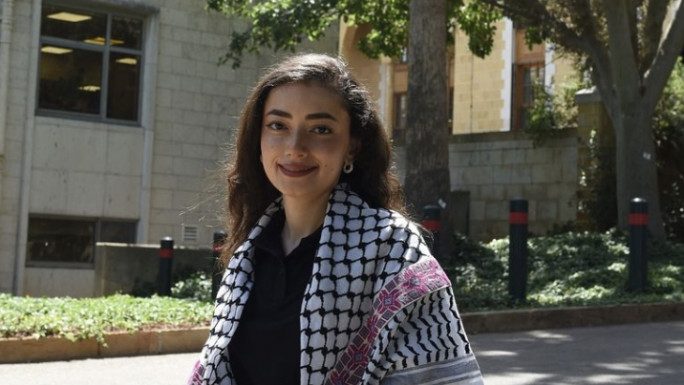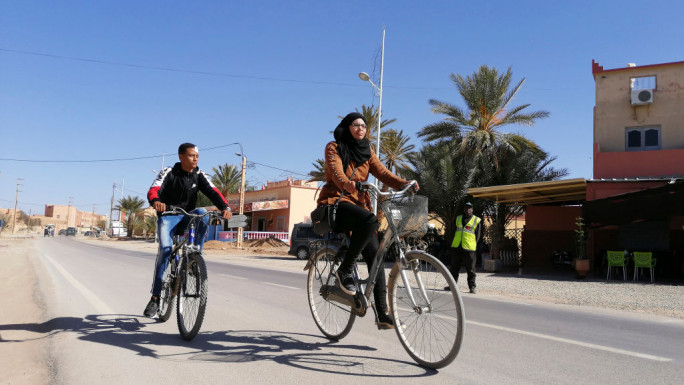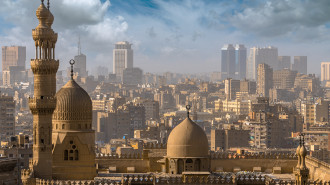
Tunisian filmmaker Ala Eddine Slim on creating alternate worlds through cinema

Defined as a “cautionary tale,” Agora impressed the jury at the Locarno Film Festival with its “artistic audacity and integrity, visionary flamboyance, and poetic call to action to avoid further cataclysm,” winning the Pardo Verde award — commonly referred to as the Green Award and usually presented to films that explore environmental themes.
Agora: 'The possibility of another world'
Since his debut feature The Last of Us (2016), taking place in an endless forest, where a kind of spiritual journey unfolds, Ala Eddine Slim has been developing his unique style by blending mysticism and imagination to create entire worlds within his films.
This approach, notable in his second feature Tlamess (2019), which premiered at the Cannes Film Festival, found its way into Agora as well.
According to the director, Agora is about humanity's struggle to move beyond the unresolved issues of a collective past but also reflects “the dream and/or nightmare of two animals observing human stupidity.”
The imagined dream of a blue dog and a black crow unfolds the plot about the return of three missing people to their hometown as ghosts.
Some locals try to keep the news quiet, but as the situation escalates, more people become involved in the mystery.
Though different in some ways, particularly with its more “classic” narrative and the presence of dialogue between actors, Eddine Slim considers Agora very much a continuation of his earlier work.
“I like to parasitise the world we live in,” he tells The New Arab, “and what you may call mysticism, I refer to as the possibility of another world.”
For him, cinema offers the freedom to juxtapose, associate, defragment, and recreate a new territory of the imaginary — a space where animals, cities, and nature coexist as instinctively as his creative process.
“I work a lot by instinct, essentially that of knowing what I won’t do in a film,” he says, reflecting on the subtle boundaries he set for himself while exploring the boundless possibilities of his craft.
The narrative of Agora has the feel of a fable, a story in which animals observe humans from a distance and comment on their deeds.
The idea hadn’t come to him fully formed; it started with a blue dog and a raven watching the return of the disappeared.
“But once,” he recalls, “I was listening to a podcast called De quoi rêvent les chiens? (What do dogs dream of?) It was the title of this podcast that gave me the idea that the whole film could be from the animals’ point of view.”
This concept gradually evolved as he rewrote the script, directing the story to be the animals’ dream or nightmare. He found the interplay between animal and human existence fascinating, each species living in its own reality.
“Our ‘simple’ human life can be an ordeal for other living beings,” he muses, “and it’s always interesting to imagine how we’re viewed from the other side, even if I’m not an animal or a plant!”
The theme of disappearance, of people vanishing at some point in their lives, had always intrigued Eddine Slim.
Missing bodies, forgotten or erased from memory, called out to him, demanding recognition. Agora is, in many ways, a transitional film for the director, one where he wanted to bring back figures from his previous films, like the drowned woman reminiscent of the lost character in The Last of Us.
He sees parallels in the real world, particularly in Tunisia, where people often disappear only to be forgotten out of fear or selfishness.
“In Tunisia and elsewhere in the world, there are always people who disappear and whom everyone ends up forgetting about, either out of fear of stirring up the past or out of egoism."
He adds, "I think it’s a big mistake to move forward without liquidating our past. One day, everything will come back to haunt us and we’ll find it hard to put things away again."
Visually, Agora is a feast of colours, each carefully chosen to enhance the film’s narrative. Eddine Slim explains that his choices often stem from instinctive desires, but they were also deeply rooted in cultural and symbolic meanings.
“For example,” he clarifies, “the colour green is often used in Muslim countries to refer to Islam, and many minarets in Tunisia are lit with green or blue lights. I also like to use blocks of light/colour as huge blobs in the frame.”
He then elaborates on the specific resonances of the colours used in Agora: “The blue of the dog is that of contaminated water, the black of the crow is that of the night in which the city is bathed, and the green of the minaret is that of nature, which is present despite everything.”
Eddine Slim's approach to working with actors is as unconventional as his visual choices. He openly admits his disdain for the immunity of the script, viewing the screenplay not as a work of art, but as a crucial technical tool.
“I hate the sanctity of the script,” he confessed. “For this reason, as with the creative team, I’m never above improvising and trying out new methods, but within the framework of a territory we define at the outset.”
Rehearsals were a significant part of his process, allowing him and the actors to explore and experiment within the story’s boundaries.
He valued the actors’ suggestions, which often illuminated aspects of the narrative he hadn’t considered, making the creative process a truly collaborative effort.
For Eddine Slim, filmmaking is less about providing answers and more about exploring possibilities. He doesn’t believe in being overly explanatory in his films, preferring instead to provoke emotions, sensations, and questions in his audience: “I respect the viewer, and I never pretend to know the truth,” he says.
“But I do offer a certain personal vision of the world and the imaginary.”
As the founder of Exit Productions, one of Tunisia’s first independent production companies, he has a front-row seat to the challenges facing the local film industry.
The current state of Tunisian cinema, he observes, is paradoxical. On one hand, there are many filmmakers creating films with interesting cinematic proposals, but on the other hand, state support has dwindled significantly in recent years.
“I think it’s a pity that the government doesn’t support filmmakers more,” he laments.
Beyond the challenges of production, distribution is another significant hurdle, even though the Tunisian public consistently flocks to see local films.
“I think the context is more global than local, that cinema is suffering just about everywhere, and that political decision-makers want to impose a certain lazy, conventional cinema. But filmmakers are resisting, and there will always be a way to make films other than those of the masses.”
Looking to the future, the filmmaker has no shortage of projects on the horizon. He is determined to continue, no matter the obstacles and he finds joy in helping his filmmaker friends with their projects: two feature-length documentaries are in the final stages of post-production, and a short film is currently in development.
“The main thing for me is not to stop too long and make films despite everything,” he concludes.
Mariana Hristova is a freelance film critic, cultural journalist, and programmer. She contributes to national and international outlets and has curated programs for Filmoteca De Catalunya, Arxiu Xcèntric, goEast Wiesbaden, etc. Her professional interests include cinema from the European peripheries and archival and amateur films



![Palestine sat next to member states at the United Nations General Assembly on Tuesday [GETTY]](/sites/default/files/styles/image_684x385/public/1441455581.jpeg?h=199d8c1f&itok=CgJaFY6v)





